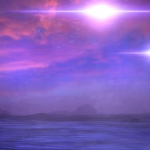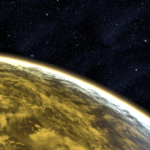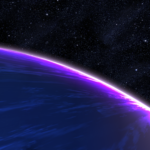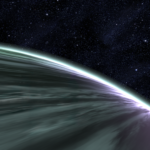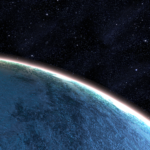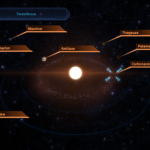System Specs:
- Stellar Mass: N/A Sol Masses
- Stellar Class: M V, M V
- Luminosity: N/A Sol
- Planets: 6
- Moons: 0
- Asteroid Belts: 1
- Asteroids: 1
- Objects: 0
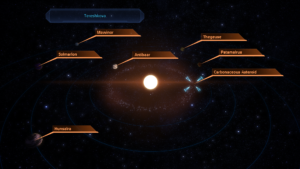
It is named after Valentina Tereshkova, the first woman to fly in space.
Tereshkova is a binary system with Tereshkova-A in the center; unlike Vamshi their combined energy is low (and the system is more explicable). It appears to be in a state of change. Patamalrus is set to lose its atmosphere and Mawinor to be ejected entirely.
–
Planets Directory:
- Antibaar
- Patamalrus
- Hunsalra
- Thegeuse
- Solmarlon
- Mawinor
–
Antibaar:
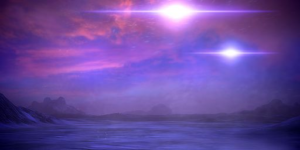
- Orbital Distance: _ 76.4 AU
- Orbital Period: _ 158.0 Earth-years
- Keplerian Ratio: _ 17.863
- Radius: _ 6,959 km
- Day Length: _ 158.0 Earth-hours
- Atmospheric Pressure: _ 0.44 atm
- Surface Temp: _ 1,157 °C
- Surface Gravity: _ 0.66 g
- Mass: _ 0.78 Earth-masses
Antibaar is a cold terrestrial world with an atmosphere of methane and argon. Its frozen surface is mainly composed of iron with deposits of magnesium. The world has been noted as a possible target for long-term terraforming; if the atmosphere could be increased to the thickness of Earth‘s, the global average temperature would rise by 10 degrees Celsius.
Antibaar’s combination of low temperatures, high speed surface winds, and low visibility make it dangerous to explore on foot.
–
Patamalrus:
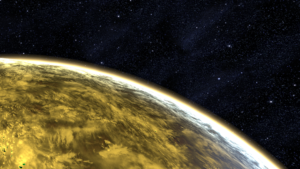
- Orbital Distance: _ 76.4 AU
- Orbital Period: _ 158.0 Earth-years
- Keplerian Ratio: _ 17.863
- Radius: _ 6,959 km
- Day Length: _ 158.0 Earth-hours
- Atmospheric Pressure: _ 0.44 atm
- Surface Temp: _ 1,157 °C
- Surface Gravity: _ 0.66 g
- Mass: _ 0.78 Earth-masses
Patamalrus‘ atmosphere is very similar to Venus in terms of pressure and temperature. Unlike Venus, however, Patamalrus’ atmosphere has a significant quantity of oxygen, both free and bound in sulfur dioxides. The surface is largely composed of magnesia with deposits of carbon. It is possible, if unlikely, that simple life may be developing on Patamalrus.
Computer modeling suggests that the powerful solar winds from the Tereshkova stars will blow off Patamalrus’ atmosphere in a few million years, lowering the temperature on the surface to the −70s.
–
Hunsalra:
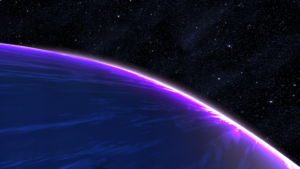
- Orbital Distance: _ 76.4 AU
- Orbital Period: _ 158.0 Earth-years
- Keplerian Ratio: _ 17.863
- Radius: _ 6,959 km
- Day Length: _ 158.0 Earth-hours
- Atmospheric Pressure: _ 0.44 atm
- Surface Temp: _ 1,157 °C
- Surface Gravity: _ 0.66 g
- Mass: _ 0.78 Earth-masses
Hunsalra is a small hydrogen-helium gas giant. It has unusually large amounts of nitrogen in the upper atmosphere, which glow purple when ionized by the solar wind. Hunsalra’s convenience as a place to dump drive charge has left its orbit littered with debris “dumped overboard” by visiting crews.
Properties
Hunsalra is too small to be a “hydrogen-helium gas giant” (William Hubbard, The New Solar System 4th ed, 1999; p. 194). It is more likely a dense “ice giant” like Neptune or Gliese 436 b.
–
Thegeuse:
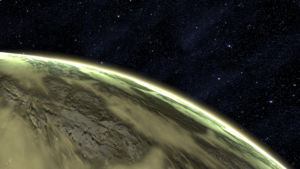
- Orbital Distance: _ 76.4 AU
- Orbital Period: _ 158.0 Earth-years
- Keplerian Ratio: _ 17.863
- Radius: _ 6,959 km
- Day Length: _ 158.0 Earth-hours
- Atmospheric Pressure: _ 0.44 atm
- Surface Temp: _ 1,157 °C
- Surface Gravity: _ 0.66 g
- Mass: _ 0.78 Earth-masses
Thegeuse is a terrestrial world with an atmosphere of chlorine and krypton. The surface is mainly composed of silicates with deposits of carbon. Thegeuse has a low mass for its size, and is tidally locked to the star Tereshkova-A. The temperature difference between the sunward “hot pole” and the dark side “cold pole” creates constant gale-force winds across the terminator.
–
Solmarlon:
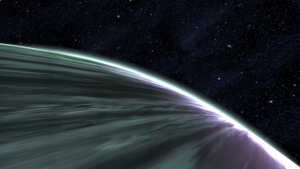
- Orbital Distance: _ 76.4 AU
- Orbital Period: _ 158.0 Earth-years
- Keplerian Ratio: _ 17.863
- Radius: _ 6,959 km
- Day Length: _ 158.0 Earth-hours
- Atmospheric Pressure: _ 0.44 atm
- Surface Temp: _ 1,157 °C
- Surface Gravity: _ 0.66 g
- Mass: _ 0.78 Earth-masses
Solmarlon is one of Tereshkova‘s two outer worlds. Significantly removed from the rest of the system, and with unstable elliptical orbits, it is thought they may have formed within 3 AU of the binary stars, and were hurled outward due to the instability of such an orbit.
Solmarlon is a hydrogen-helium gas giant with significant quantities of sodium in the upper atmosphere, giving it a distinct grey color.
–
Mawinor:
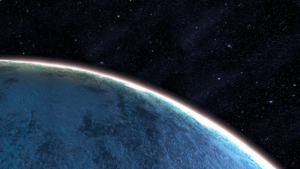
- Orbital Distance: _ 76.4 AU
- Orbital Period: _ 158.0 Earth-years
- Keplerian Ratio: _ 17.863
- Radius: _ 6,959 km
- Day Length: _ 158.0 Earth-hours
- Atmospheric Pressure: _ 0.44 atm
- Surface Temp: _ 1,157 °C
- Surface Gravity: _ 0.66 g
- Mass: _ 0.78 Earth-masses
Mawinor is the second of Tereshkova‘s outer worlds. It is essentially a rock of unremarkable ores with some deposits of water ice, but no minerals of value. The frozen surface is composed of silica.
Like the gas giant Solmarlon, it is thought that Mawinor formed too close to the Tereshkova stars and was thrown outwards by gravitational effects. Computer models suggest it will be ejected from the system in a few hundred thousand years.
–
video

